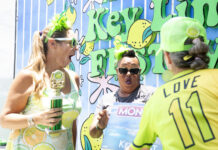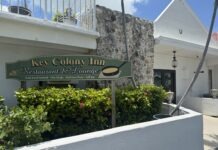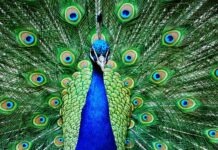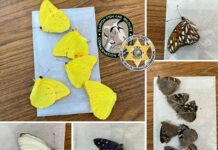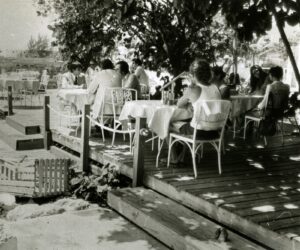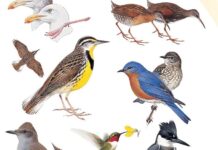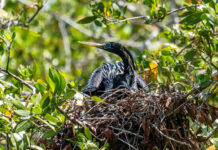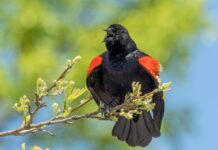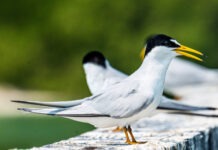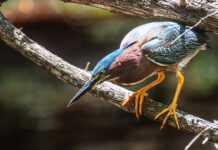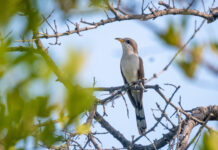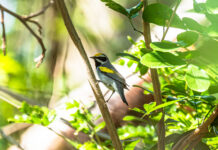
Of the many arguments I’ve gotten into online, one that has stuck with me the longest was about prothonotary warblers and the origin of their name.
I mean, “prothonotary” is a pretty obscure 25-cent word and for the longest time I didn’t think about what it meant. I was mostly happy once I learned to pronounce it the way everyone else did: pro-THON-uh-tary. There are a lot of opaque, hard-to-parse descriptives in bird names – pied, semipalmated, pomarine, greylag, whooper, etc. – and sometimes it takes you a while to track down their origins and meanings.
For instance, I just thought to look up pomarine for the first time in a quarter century of being a birder. I know the word from pomarine jaeger, a very aggressive pelagic bird occasionally seen off our shores. It turns out it refers to a roof-like covering over their nostrils. (Next time I see a lifeguard with one of those plastic nose-protector things, I’m going to refer to them as a pomarine lifeguard.)
A prothonotary is a kind of functionary, a clerk of the court, a boss of the notaries, the person who manages the scribes. Its meaning shifts, like “adult” or “literally,” though maybe to a lesser degree, but prothonotaries were essentially upper-level bureaucrats in whatever organizational entity they were with. The legend is that the warbler was named after them because of the saffron colored robes the prothonotaries wore, the way northern cardinals were named after the scarlet red robes worn by Roman Catholic cardinals.
The argument I got into about their name was with a guy named Rick Wright, who I met years ago on a trip to Guyana, and who was one of the more scholarly birders I have ever met. He’d posted something on Facebook about how everyone treated the saffron robes thing as gospel, but he could find absolutely no historical records of any prothonotaries actually wearing saffron colored robes, so people should stop saying that was the case. Or something loosely to that effect. It’s been a couple years.
My thought was there was so much human history, so many small trends and interactions and cultural and subcultural eddies that went unrecorded in any kind of way, that saying something wasn’t true because there was no official record of it didn’t mean it was untrue, and that the story of them wearing saffron colored robes that has endured for a couple centuries should be enough to prove that they wore saffron colored robes, or at least allow for the possibility. Wright thought otherwise.
Saying it was an argument is probably an overstatement. A small disagreement might be a better description. Wright may not even have noticed at the time, or ever. But I remember walking the dog afterward (I think it was the Fourth of July, I forget what year) and grumbling to myself about academics and gatekeepers and revisionists for a good 20 minutes before I forgot about it. But I have thought about it, on average, twice a year since, though usually more often in the fall than the spring.
Prothonotary warblers are for the most part southeastern birds, though their range stretches as high as Michigan and Wisconsin. They are denizens of wooded bottomlands and forested swamps. We see them here in migration, most often early on on their way south. At least I think it’s more often. It might just be that they make such a stronger impression in the fall.
They are one of the earlier migrants in the parade of warblers that come through in August and September. And after seeing almost nothing besides northern mockingbirds, gray kingbirds and common grackles for several months, catching sight of one of them on the side of a trail always stops me in my tracks and fills me with a little joy and a little relief.
There are flashier birds in the world, and flashier warblers, but there is something about prothonotaries. I’d say a seriousness or a gravitas, but that’s too anthropomorphic. I don’t want to say they’re a more beautiful yellow than, say, corn, marigold, Big Bird, or school buses, but it seems to be deeper, more complex, more evocative, more reminiscent of the yellows in Van Gogh’s sunflowers or Monet’s irises than that of a smiley face.
It’s possible I’m bringing my own emotional baggage to this. But damn, was I glad to see three or four of them while I was walking along one of the trails at the Key West Botanical Garden with my friend Ellen Westbrook the other day. They flitted along the path ahead of us, looking like glowing embers in the shadows, eating bugs and berries, bulking up for the rest of their trip.
Rick Wright actually wrote a pretty great essay on his blog about his issues with the whole yellow robe thing, doing as deep a dive as he felt it was possible to go. In it he points out that the yellow robes are variously attributed to Roman Catholic Church lawyers, to the chief secretary of the Chancery at Rome, to notaries in the Byzantine courts, and to papal clerks. It was the lack of consistency that got him. And the lack of a primary source for the story. And the fact that he couldn’t find any reference to any of the actual lawyers, clerks or notaries actually wearing yellow robes in any references he read about them.
According to Wright, the first known reference to the name prothonotary was in an account from 1785 and attributed to the French-speaking inhabitants of Louisiana, who referred to the species as “le Protonotaire.” In reference to the why of the name, the account noted, “The reason has not reached us.”
There was, during the era, a position in the local government known as le Protonotaire, but there does not seem to be any known record of what they wore.
Wright concluded that the origin of the name will probably never really be known, and he’s probably right. But I’m sticking to the yellow robes story. I’ll just be adding the phrase “possibly apocryphal” to it.



